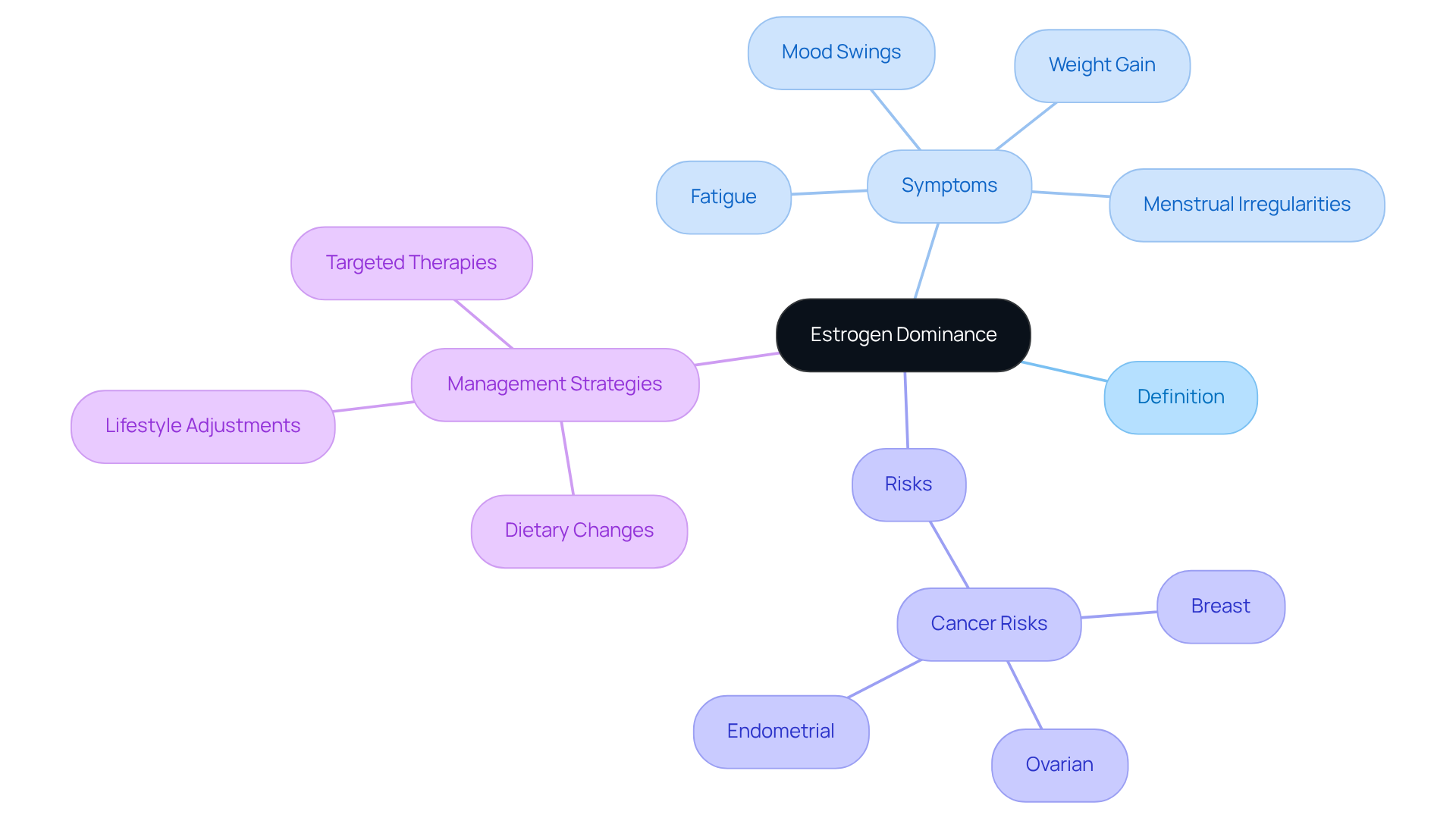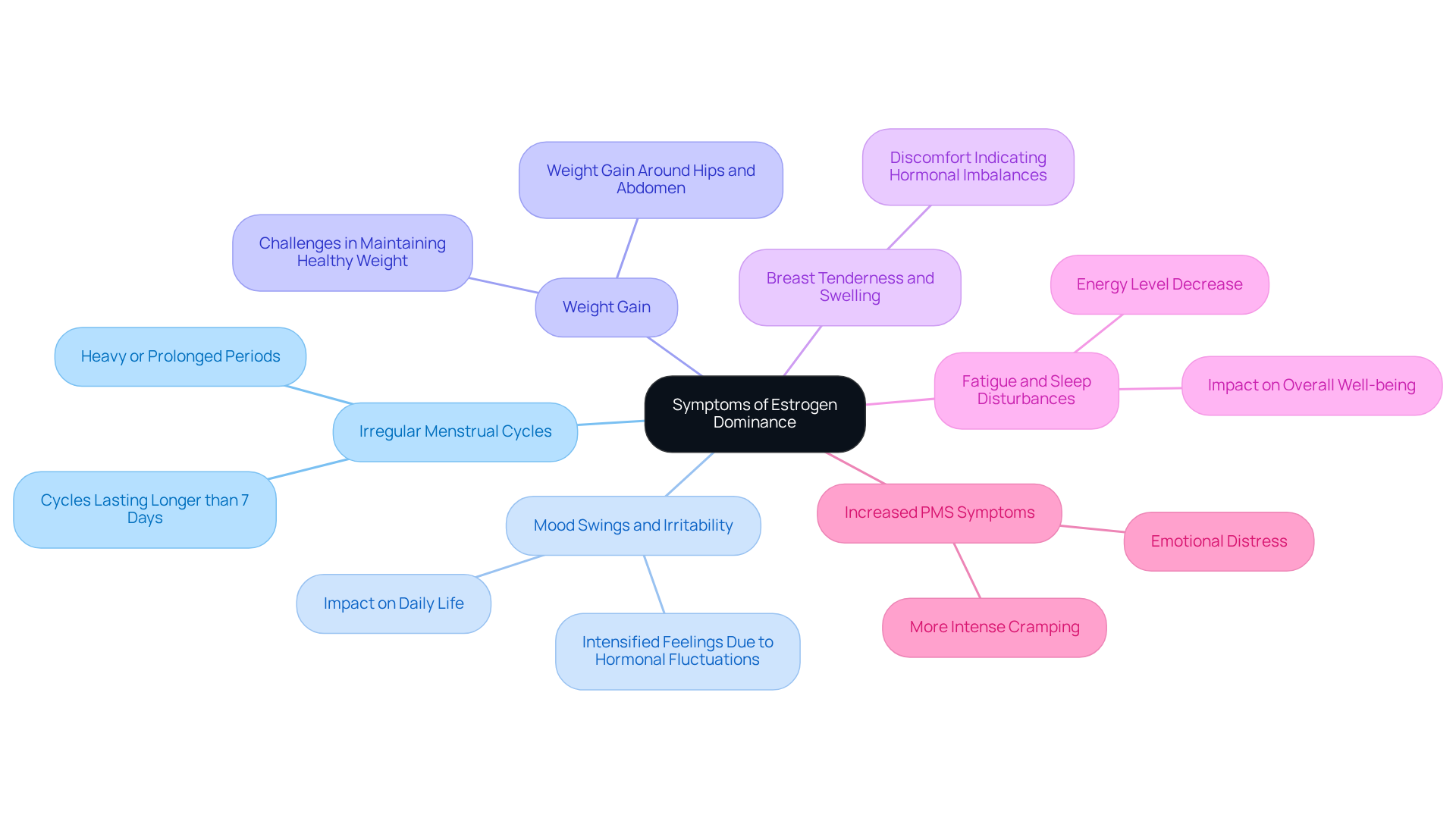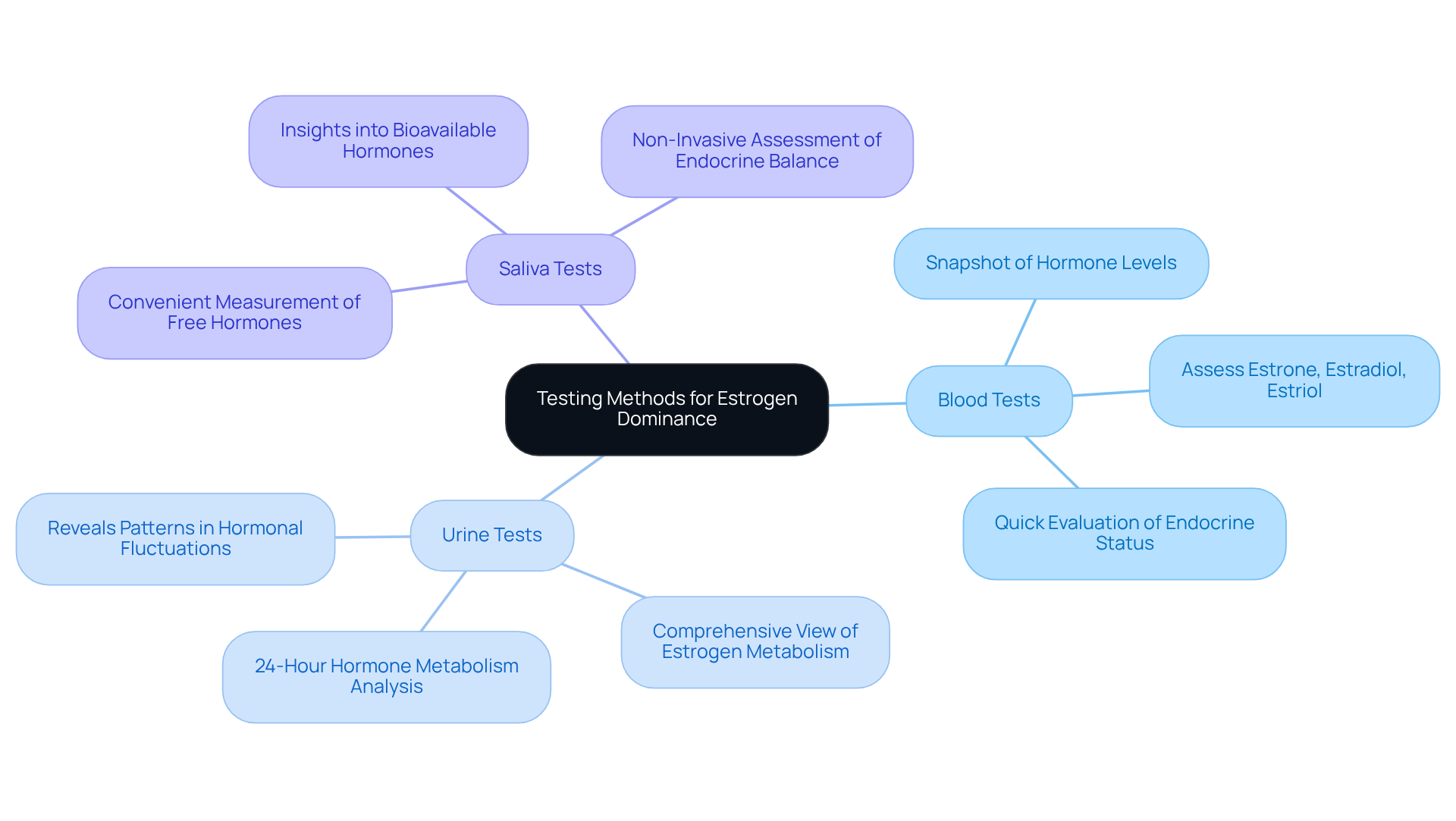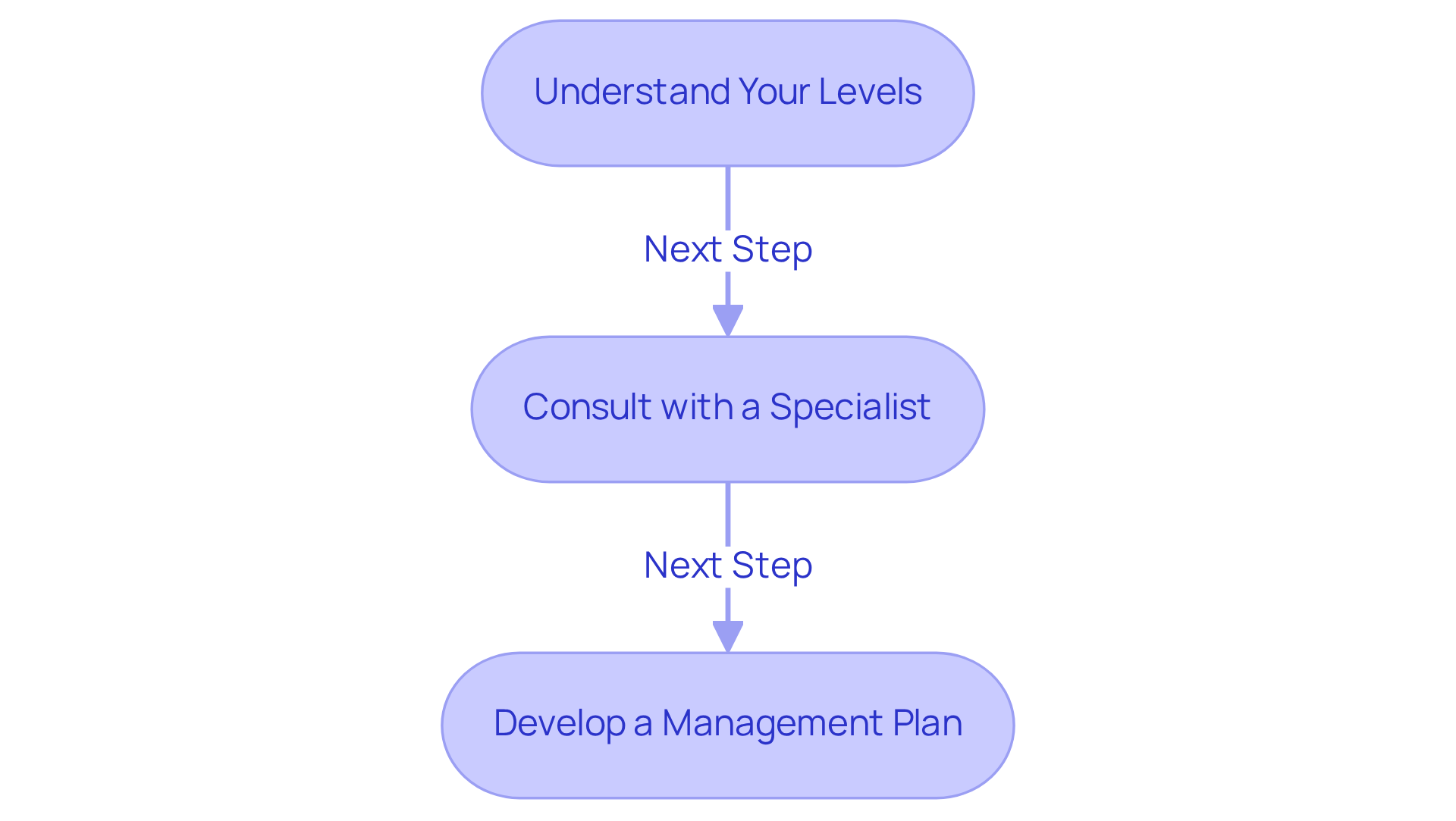Introduction
Understanding hormonal balance is crucial, especially when many of us face the challenges of estrogen dominance. This condition can disrupt both our physical and emotional well-being, leaving us feeling out of sync. We understand how overwhelming this can be, and that’s why this article delves into effective strategies for identifying and testing for estrogen dominance. Here, you’ll find valuable insights into recognizing symptoms and choosing the right testing methods that suit your needs.
But with so many testing options available, how can you determine the most effective approach to regain your hormonal balance and improve your overall health? Together, we can explore these options and find the best path forward in your wellness journey.
Understand Estrogen Dominance: Definition and Importance
Hormonal dominance can feel overwhelming, especially when it manifests as a biochemical imbalance with increased female hormone levels compared to progesterone. Many individuals experience symptoms like mood swings, weight gain, fatigue, and menstrual irregularities. For those navigating the challenges of menopause, understanding hormonal dominance is crucial. It can significantly impact not just physical health but also emotional well-being and overall quality of life.
Consider the real-world implications: countless individuals report struggles with persistent abdominal fat, thinning hair, and mood fluctuations – all linked to this hormonal imbalance. Moreover, elevated hormone levels can increase the risk of various cancers, including breast, ovarian, and endometrial types in women. With over a billion people expected to face menopause by 2030, the need for awareness and effective management strategies is more pressing than ever.
Endocrinologists stress the importance of a test for estrogen dominance to identify hormone dominance and create tailored treatment plans. By understanding this condition, individuals can take proactive steps toward restoring hormonal balance, including the option to conduct a test for estrogen dominance. This might include dietary changes, lifestyle adjustments, and targeted therapies like DIM supplementation, known for improving metabolite ratios. This holistic approach not only addresses symptoms but also empowers women to enhance their health during this pivotal life stage.
Together, we can navigate these challenges. If you’re experiencing symptoms of hormonal dominance, consider reaching out for support. You don’t have to face this journey alone – there are effective strategies available to help you regain control and improve your well-being.

Identify Symptoms of Estrogen Dominance
Recognizing common symptoms of estrogen dominance is the first step toward understanding your health. Here are some signs to look out for:
- Irregular menstrual cycles: You might notice heavy or prolonged periods that last longer than seven days.
- Mood swings and irritability: These feelings can be intensified by hormonal fluctuations, impacting your daily life.
- Weight gain: Many find it challenging to maintain a healthy weight, especially around the hips and abdomen.
- Breast tenderness and swelling: This discomfort may indicate hormonal imbalances.
- Fatigue and sleep disturbances: These can significantly affect your overall well-being and energy levels.
- Increased PMS symptoms: You may experience more intense cramping and emotional distress than usual.
Identifying these symptoms is crucial for understanding potential hormone imbalances and determining if one should test for estrogen dominance. Many women in their 30s to early 50s report experiencing these signs, particularly during perimenopause. It’s important to be aware of these changes, as a test for estrogen dominance can help identify untreated hormone dominance that may lead to more serious health issues, including an increased risk of breast and uterine cancers.
By recognizing these signs early, you can take proactive steps toward achieving hormonal balance. We understand that this journey can feel overwhelming, but together we can work towards improving your quality of life. If you resonate with any of these symptoms, consider reaching out for additional assessment and testing. Your health matters, and taking action today can lead to a brighter tomorrow.

Explore Testing Methods for Estrogen Dominance
Testing for estrogen dominance can feel overwhelming, but understanding your options can empower you on your wellness journey. Here are several effective methods to consider:
-
Blood Tests: Conducted by healthcare providers, blood tests assess levels of estrone (E1), estradiol (E2), and estriol (E3). This method provides a snapshot of hormone concentrations at a specific moment, allowing for a quick evaluation of your endocrine status.
-
Urine Tests: Offering a broader perspective, urine tests analyze hormone metabolism and levels over a 24-hour period. This comprehensive approach can reveal patterns in female hormone excess, making it a valuable tool for a test for estrogen dominance and understanding hormonal fluctuations. As hormone experts note, a test for estrogen dominance using urine testing offers a more comprehensive view of estrogen metabolism, which is essential for evaluating balance in hormones.
-
Saliva Tests: Known for their convenience, saliva tests measure free hormone levels, giving insights into the bioavailable hormones that actively influence your body. This technique is particularly effective for assessing endocrine balance in a non-invasive manner.
Each testing method, such as the test for estrogen dominance, has its unique advantages, and the choice often depends on your individual health circumstances and the guidance of your healthcare provider. Furthermore, current trends show a growing preference for urine testing due to its ability to reflect long-term endocrine patterns, while many appreciate saliva testing for its ease of use.
Did you know that over 50 million individuals enter menopause each year? This statistic highlights the importance of hormone testing. In addition, 81.4% of women reported improvement in menopause-related symptoms after 12 months of using transdermal estradiol spray. This further emphasizes the relevance of these testing options as more individuals seek to gain a clearer understanding of their hormonal balance through a test for estrogen dominance. Together, we can explore these options and take steps toward a healthier you.

Prepare for Your Estrogen Dominance Test
To effectively prepare for your estrogen dominance test, it’s important to follow these essential steps:
- Consult with Your Healthcare Provider: We understand that navigating health concerns can be overwhelming. Engaging in a detailed discussion with your healthcare provider about the test for estrogen dominance that aligns best with your symptoms and health history is crucial. This personalized approach ensures you receive the most relevant test for estrogen dominance based on your unique situation.
- Timing is Key: Have you considered how timing can impact your results? For blood tests, it’s generally advised for women to schedule testing during the luteal phase of the menstrual cycle, specifically around days 19 to 21. This timing helps capture the fluctuations in hormones that are essential for a precise evaluation.
- Medication Considerations: Before testing, you may need to pause hormone replacement therapy or other medications that could skew hormone levels. This step is vital for obtaining a clear picture of your endocrine status, allowing for more accurate results.
- Stay Hydrated: Staying hydrated is important, especially if your test involves blood or urine collection. Drinking plenty of water can facilitate the testing process and improve the accuracy of your results.
- Real-Life Experiences: Many patients have found that thorough preparation not only alleviates anxiety but also leads to more reliable test outcomes. Sharing experiences with others who have undergone similar testing can provide valuable insights and reassurance.
By adhering to these guidelines, you can enhance the accuracy of your test results and gain a clearer understanding of your hormonal health. Together, we can navigate this journey towards better wellness.

Interpret Test Results and Plan Next Steps
Upon receiving your test for estrogen dominance results, it’s essential to take some thoughtful steps to ensure your hormonal health.
-
Understand Your Levels: Start by reviewing your estrogen and progesterone levels in relation to the normal ranges provided by your healthcare provider. For instance, typical hormone concentrations for premenopausal women generally range from 30 to 400 picograms per milliliter (pg/mL). If you notice increased estradiol levels compared to progesterone, it may be necessary to test for estrogen dominance, which can lead to symptoms like weight gain, mood swings, and sleep disruptions. Understanding these levels is the first step toward feeling better.
-
Consult with a Specialist: Next, consider scheduling a discussion with a hormone therapy specialist or your healthcare provider. They can offer personalized insights and recommendations based on your unique biochemical profile and health history. Engaging with a knowledgeable professional is crucial for grasping the implications of your results and exploring potential treatment options. Remember, you’re not alone in this journey.
-
Develop a Management Plan: Based on your test results, your provider may suggest a comprehensive management plan tailored to your needs. This could involve lifestyle modifications, dietary changes, or hormone therapy options. For example, incorporating cruciferous vegetables into your diet can support hormone metabolism, while regular exercise is recommended to maintain a healthy weight and regulate hormone levels. Together, we can create a plan that works for you.
Taking these proactive steps can empower you to manage your hormonal health effectively, leading to improved overall well-being. As hormone therapy specialists emphasize, understanding the root causes of estrogen dominance is vital for developing effective strategies to test for estrogen dominance. So, let’s take this journey together!

Conclusion
Understanding and addressing estrogen dominance is crucial for achieving hormonal balance and enhancing overall health. This guide has offered a thorough overview of the steps needed to effectively test for estrogen dominance, empowering you to take charge of your hormonal health. By recognizing symptoms, exploring testing methods, preparing for tests, and interpreting results, you can navigate your wellness journey with confidence.
Key insights discussed include the importance of identifying symptoms such as:
- Irregular menstrual cycles
- Mood swings
- Weight gain
These may signal hormone imbalances. Various testing methods – blood, urine, and saliva tests – provide different perspectives on hormonal levels, enabling tailored approaches to treatment. Furthermore, proper preparation for testing can enhance accuracy and reliability, ensuring that results lead to informed decisions about your health management.
Ultimately, the significance of testing for estrogen dominance cannot be overstated. As more individuals seek to understand their hormonal health, taking proactive steps can lead to improved well-being and a better quality of life. Engaging with healthcare providers and utilizing effective testing methods is essential in this journey, as it opens the door to personalized strategies for managing hormonal imbalances. Together, we can take action today to pave the way for a healthier tomorrow.
Frequently Asked Questions
What is estrogen dominance and why is it important to understand?
Estrogen dominance refers to a biochemical imbalance where there are increased female hormone levels compared to progesterone. Understanding it is crucial as it can significantly affect physical health, emotional well-being, and overall quality of life, especially during menopause.
What are some common symptoms of estrogen dominance?
Common symptoms include irregular menstrual cycles, mood swings and irritability, weight gain (particularly around the hips and abdomen), breast tenderness and swelling, fatigue and sleep disturbances, and increased PMS symptoms.
Who is most likely to experience symptoms of estrogen dominance?
Many women in their 30s to early 50s, particularly during perimenopause, report experiencing symptoms of estrogen dominance.
What are the potential health risks associated with estrogen dominance?
Elevated hormone levels linked to estrogen dominance can increase the risk of various cancers, including breast, ovarian, and endometrial cancers in women.
How can one identify estrogen dominance?
A test for estrogen dominance is recommended by endocrinologists to identify hormone dominance and create tailored treatment plans.
What steps can be taken to address estrogen dominance?
Proactive steps include dietary changes, lifestyle adjustments, and targeted therapies such as DIM supplementation, which can improve metabolite ratios and help restore hormonal balance.
What should someone do if they experience symptoms of estrogen dominance?
If experiencing symptoms, it is advisable to reach out for support and consider testing for estrogen dominance to determine appropriate management strategies.









